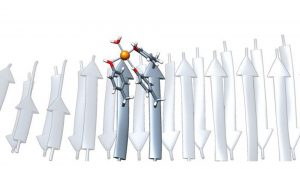A team of researchers from Universitat Autonoma de Barcelona (UAB) has developed new nanozymes that are designed with carbon capture capacity.
The nanozymes can capture carbon emitted in industrial processes and are applicable to other environmental remediation processes. They are based on artificial molecular structures formed by the peptides of seven amino acids.
The new molecules could also act as metalloenzymes. This ability opens up new possibilities in biotechnology research.
The study, ‘Amyloid Fibrils Formed by Short Prion-Inspired Peptides Are Metalloenzymes,’ provides a new contribution to the origin of catalytic activity at the beginning of life.
The team created self-assembling molecules
In 2018, the researchers created short molecules that were capable of self-assembling. The design was inspired by amyloid fibrils’ natural ability to self-assemble, and a sequencing of specific prion proteins.
Artificial amyloids have catalytic activities. In comparison to natural enzymes, they also have a variety of benefits, including modularity, flexibility, stability, and reutilisation.
Now, the team found that they have the capacity to bind to metal ions effectively and act as metal and metalloenzyme-storage elements.
Salvador Ventura, coordinator of the research, said: “These peptides were particular, since they did not contain the typical amino acids, such as histidine, which is often considered essential for the coordination of metal ions in enzymes, and which were thought to be essential for catalytic activity.
“In contrast, they were enriched with residues from tyrosine, an element which although less known in this context, can also have the unique capacity of binding to metal ions if it finds itself in the correct structural context.
“Tyrosine’s ability to do so is what we used to create our new nanozymes.”

Applications of the new nanozymes
Because nanozymes are stable, they can be used for environmental remediation, in wastewater treatment processes or contaminated soils, and have the capacity to sequester metal ions.
The new nanozymes are function as metallonenzymes. This means that they are capable of catalysing reactions in conditions in which current enzymes are incapable of acting because they are less stable.
This opens up new possibilities in research into biotechnology. For example, in catalysing reactions in extreme temperatures and pH values.
Based on the new nanozymes, the team believes that have developed a minimalistic variant of a carbonic anhydrase enzyme. It has the potential to capture carbon emitted by greenhouse gases, and has a much lower production cost than natural enzymes.
How were the nanozymes developed?
To develop the new nanozymes, the team formed the hypothesis that catalytic activity at the origin of life could have materialised due to the self-assembling of short, low-complexity peptides into structures similar to amyloids. These acted as primal ancestral enzymes.
“Showing that these molecules have catalytic action without the need of conventional histidine-based coordination represents a significant change in how we understand the origin of catalytic activity at the start of life.
“We now know that this activity can be achieved if the ancestral peptides contain tyrosine.
Therefore, we suggest that it is highly probable that the ancestral enzymes based on amyloids also used this second amino acid in their chemical reactions,” concluded Ventura.





